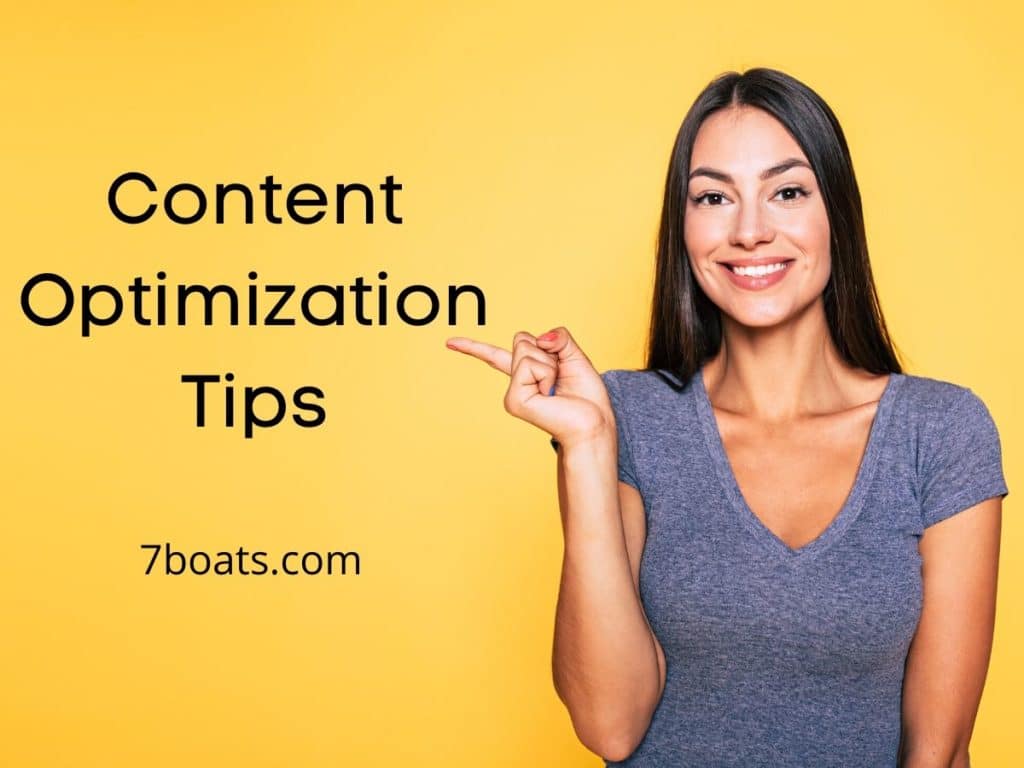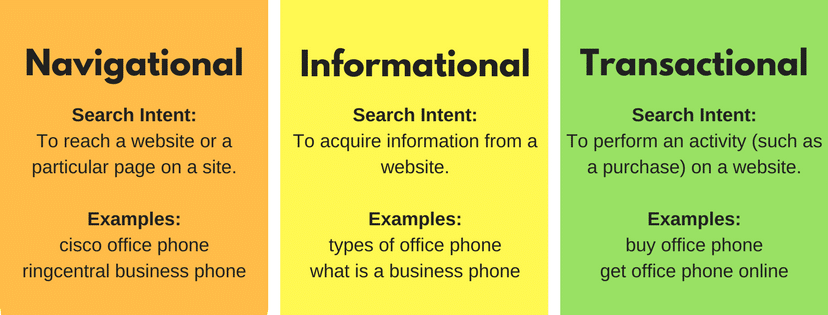
What is the usual way of content optimization?

You follow the traditional method of SEO. You check up keyword tools, do keyword research & select keywords, develop content on those keywords, optimize your website on those keywords and keep your fingers crossed for the search crawlers to recognize and appreciate your effort! What it means is that this type of content development is all about YOU.
Related reading: Best on page SEO tips

User Intent is Very Important in content optimization
That is not how Google views the online content scenario. Google wants to make searches all about the user. That is why it is concentrating hard on getting the intent of the user right. That is why it wants the user to find what they are looking for quickly and more effectively. If the Big Daddy wants to look after the user and put the nameless faceless entity on the other side of the digital screen in the driver’s seat, who are we to do anything otherwise?
There is another observation I want to make here. It is rather interesting. Most of the optimization of the website, on page and off page, is done before a website is launched. This is before the users come into the picture. As a result, the optimization has nothing to do with the users who are actually using your website. In other words, the user factor is not even considered in the optimization process. It means that the input of the user, their likes or dislikes and other aspects are not part of the decision making process about the optimization.
Target your customer first to better understand the user intent
Yet, digital marketers and SEO enthusiasts shout themselves hoarse about user experience! It is a rather ironic scenario.

Keeping this in mind, I have come across some methods by which you can pull yourself out of this warp. The core purpose of this process is to optimize the page from the user’s point of view. How would your user optimize your web pages if they could have a go at it? That is what you should think about. It is not difficult or doing something drastically different. It is simply a case of preparing your site’s SEO from the user’s viewpoint as opposed to yours.
Start off by marking out the web pages in your site that do not perform as per expectations. There is no rule that says that high performing pages are better in content quality than these other unfortunate pages that do not make a mark on either the SEO scene or on the mind of the user. However, there must be something amiss that is drawing away the potential of these pages.
[ Related course: Check out our online SEO training course ]
Google prefers user intent than technical finesse

User intent or Technical finesse? Most web site owners and creators are concerned about the technical details of a site. The general perception is that a site needs to tick several boxes before it finds favour with Google’s algorithms. The most obvious among these check boxes is the ability of the site to maintain technical finesse. Web owners feel that without the right technical backend, sites will not be able to impress Google algorithms. However, it appears that all along these site owners were barking up the wrong tree!
User intent or technical finesse which one is important?
In a hangout session where John Mueller usually answers questions put forward by users, he has suggested through an answer to a query that technical finesse is not all for Google.
What is more important is the ability of the site to offer precise answers to a user’s query.
If the users visiting the site don’t have the satisfaction of having their question answered, a site’s presence on Google SERP is not validated. In such a situation, the site’s presence can feel threatened.
The question asked in the first place was about a site which had an otherwise impeccable technical background but was unable to shore up its rankings on Google.
In reply to this, Mueller suggested checking if the site was doing enough in terms of content. He offered to say that the site owner may be too caught up by the technical aspects of a site to concentrate on the more basic question of whether the site is able to offer quality experience to users. Without that factor taken care of, sites cannot enjoy a favourable spot on Google.
Here is the complete transcript of the answer offered by John Mueller:
Focus more on user intent to rank better on SERP
“This is always kind of a tricky situation where you’re working on your website for a while, then sometimes you focus on a lot of the technical details and forget about the bigger picture.
So what I would recommend doing here is taking your website and the queries that you’re looking [to rank] for, and going to one of the webmaster forums.
It could be our webmaster forum, there are lots of other webmaster forums out there where webmasters and SEOs hang out. And sometimes they’ll be able to look at your website and quickly pull out a bunch of issues. Things that you could be focusing on as well.
Sometimes that’s not so easy, but I think having more people look at your website and give you advice, and being open to that advice, I think that’s an important aspect here.
Another thing to keep in mind is that just because something is technically correct doesn’t mean that it’s relevant to users in the search results. That doesn’t mean that it will rank high.
So if you clean up your website, and you fix all of the issues, for example, if your website contains lots of terrible content then it still won’t rank that high.
So you need to, on the one hand, understand which of these technical issues are actually critical for your website to have fixed.
And, on the other hand, you really need to focus on the user aspect as well to find what are issues that users are having, and how can my website help solve those issues. Or help answer those questions.”
Don’t optimize for generic keywords
What can it be? It is usually the mismatch between the intent of the user and the content that you are providing on that particular page. User intent and content optimization are highly interlinked for better search ranking.
For example, if the user visits the page expecting tips on how to buy a smartphone, they end up finding a list of smartphone dealers in their locality. That may be helpful for them eventually, but that is not what they are looking for when they visited your page. These cases are very common especially when you optimize on generic keywords.
You need to pull up the content on these pages and design them for user satisfaction and need. The pages must have the ability to match up to the expectations of the user. You can tweak meta tags, title and descriptions, along with the call to action (CTA). Additionally, help users close a task to completion. Users need a little nudge towards finality. Help them achieve that end through your content and page designing.

Once you have evaluated the content through the prism of the user, submit them for reindexing on Google via Google search console . The validation of the process and its success or otherwise is immediately available! You can see the results in a short time. When you get the results, usually in a day or two or even lesser time, it is time to measure the indices again whether your content optimization techniques are working or not. Find out the degree of engagement, like click through rates (CTR) or conversion rate. You must target for better CTR.

If the results are at par with your expectation, keep moving ahead. Otherwise, tweak things around and test again. It may be that you don’t get it right the very first time you do it.
SEO tutorial for beginners
eCommerce Content Optimization – The Necessity of Tightening Ecommerce Content
Fine tune your ecommerce content to get better SEO benefit!

eCommerce Content Optimization
Just like your garden, your well-maintained ecommerce website can give way to unwanted undergrowth and weeds. To continue with the same analogy, this additional but unnecessary growth of weeds competes with plants that are supposed to fill up your garden. As a result, the weeds and the beautiful flower plants fight over sunlight, fertilizer and water.
As a gardener, you want to throw out these weeds so that all of these growth incentives are available to plants that you actually want to grow. It is, therefore, very important that you cut out the weeds and prevent them from going back. This is like protecting the desired plants to have the best chance of growing up into beautiful flower or ornamental trees.
Ecommece Content Optimization – SEO & User Experience
The SEO of your ecommerce venture is eerily similar. Here, the weeds are all those pages that have got added to your ecommerce site over the years due to various reasons. A prime example of this kind of pages is the now obsolete practice of content farming. You added so many unnecessary pages to the site, expecting it to fire up your chances with Google. Now they hang heavy upon the soul of your ecommerce site! That’s the reason you need ecommerce content optimization.
These additional unwanted pages tamper and dilute the user experience of your website. Users often chance upon these pages, and they do not present a very pretty or flattering picture of your website! Moreover, they create hurdles for Google’s algorithms to index pages that you want to find on the SERPs. Some of them have lodged themselves comfortably in the index directories of Google, narrowing down the room for your updated and wanted pages on these directories.
To cut a long story short, you need to tighten the ship and ensure that your eCommerce site has the best possible chance to move ahead. Pruning the website becomes very important. With the website pruned for Google’s algorithms and for users, you end up making the website light on its feet. The bloated belly is gone along with some adipose tissues here and there! You have a sleek website on the race track, one with a much improved chance of winning the marathon.
ECommerce Content Optimization – Scrubbing out unnecessary thin content
Now, that you have a fair bit of idea about why you need to prune down the content on your site, here is a quick list of those types of content that you would want to scrub out:
- Thin Content: You need their presence because they have a SEO standing. However, the title and meta tags are not enough to justify their presence on SERPs. You have to improve the content on these pages and make their presence on the SERP count. Only then can they add value to your website.
- Lacklustre Content: This is referring to those pages that fill up your website without getting any or little attention from the visitors to your site. There are almost no shares on this content, not much traffic coming to them and certainly no sales happening. You want to get rid of these pages so that you can fill up those gaps with content that performs.
- Duplicate Content: This is obviously the kind of content that should never have been there in the first place! They are an embarrassment not just for the users but also for search engine crawlers. You need to dump them ASAP.
- Out of Stock: Even on reputed sites like Flipkart, you will find tons of product pages that showcase out of stock products. These are not shelves that will be filled up as stocks arrive. These are shelves of products that are not manufactured anymore! Yet, the pages are live online and people often end up visiting them. You have to scrub out such pages from your ecommerce site.
How to do ecommerce optimization
- Old content optimization is a must. Along with new blog posts or new product uploads, you need to optimize and update your old blogs on regular basis to make them as evergreen content. This is the most important ecommerce content optimization tip.
- Another ecommerce content optimization tip is to remove unnecessary tags from your website or make them noindex, follow
- Add disallow in your robots.txt for the variation of products (size, colour, sorting option etc) to minimize the risk of duplicate content.
- Make your boilerplate content (Header or Footer or sidebar) less.
- Update product descriptions, price etc on regular basis. Hide or noindex out of stock products.
- Write unique titles, product descriptions, proper call to action buttons
- Add product reviews, ratings, offers, schema mark up.
- Your content must be matching to the user intent – the behind the scene intention of a search term users searching to find your product.

Your aim is to put your best ecommerce site over to the users. If you need to cut down on some frills, especially when they are hindering a seamless experience of exploring the ecommerce site, you should do that without a care or worry. With a tight and pruned site, you have better chances of running long and hard.
Related reading: eCommerce copywriting tips
Get a content audit done and slip off those wings that are, instead of helping you fly, pulling you down.
How to do eCommerce SEO
How to Handle Low Traffic Website? – Content Optimization techniques for low traffic websites

How to handle a low traffic website? All webmasters have some web pages on their websites which are not very popular. There is hardly any traffic movement and visitors don’t like to visit these web pages. When you check Analytics, you find that these pages are as good as non-existent. You will obviously be asking the question then: do you actually need them to stay online? Or is there a better way to handle traditionally non-performing web pages on your websites?
The question is tricky, simply due to the number of variables involved. Firstly, a non-performing page in terms of the number of visitors coming to the page is not really a reliable metric. This was pointed out by none other than John Mueller of Google during an interactive session on Google Hangout.
There are some topics and content which have a niche audience. It is not for everyone, like a page of research material. However, if they are relevant information for your website, you need to keep them online despite their lack of visitors. Google’s algorithms will not judge you harshly because the page views are low on a particular web page, something which was made clear by Mueller.
There is the option of pruning the content which is not working or adding value to your website. You can do it in two ways, according to Mueller.
How to Handle Low Traffic Web Pages
- Remove the content from your website – But if the page is relevant and important to your purpose, you should simply keep it despite the tag of poor performance in terms of visitors
- You can improve the content – If you feel that the content on the site is poorly written or is shallow in terms of material, you can improve the quality and check for a difference in the number of visitors
Content and quality questions
- Does the content provide original information, reporting, research or analysis?
- Does the content provide a substantial, complete or comprehensive description of the topic?
- Does the content provide insightful analysis or interesting information that is beyond obvious?
- If the content draws on other sources, does it avoid simply copying or rewriting those sources and instead provide substantial additional value and originality?
- Does the headline and/or page title provide a descriptive, helpful summary of the content?
- Does the headline and/or page title avoid being exaggerating or shocking in nature?
- Is this the sort of page you’d want to bookmark, share with a friend, or recommend?
- Would you expect to see this content in or referenced by a printed magazine, encyclopedia or book?
Expertise questions
- Does the content present information in a way that makes you want to trust it, such as clear sourcing, evidence of the expertise involved, background about the author or the site that publishes it, such as through links to an author page or a site’s About page?
- If you researched the site producing the content, would you come away with an impression that it is well-trusted or widely-recognized as an authority on its topic?
- Is this content written by an expert or enthusiast who demonstrably knows the topic well?
- Is the content free from easily-verified factual errors?
- Would you feel comfortable trusting this content for issues relating to your money or your life?
Presentation and production questions
- Is the content free from spelling or stylistic issues?
- Was the content produced well, or does it appear sloppy or hastily produced?
- Is the content mass-produced by or outsourced to a large number of creators, or spread across a large network of sites, so that individual pages or sites don’t get as much attention or care?
- Does the content have an excessive amount of ads that distract from or interfere with the main content?
- Does content display well for mobile devices when viewed on them?
Comparative questions
- Does the content provide substantial value when compared to other pages in search results?
- Does the content seem to be serving the genuine interests of visitors to the site or does it seem to exist solely by someone attempting to guess what might rank well in search engines?
Evaluation of the content will show you the right path.
Related reading: Content marketing tips
Content Optimization Tips: New Trust Indicators for Content on Google

The doubt on accuracy about information gleaned online is as ancient as the internet! People are often questioning the authenticity of information they gather online, especially if that material goes against the general grain of their own understanding of the subject. And there is enough reason to question what you read online. More often than not, content makers punch in promotional material and misleading information to fulfill their objectives, leading unsuspecting readers on the wrong path.
Related reading: how to detect fake news
Of late, there is an effort being made by every big player online. Facebook and Google are definitely at the forefront of this initiative to ensure that you read authentic information. Or at least, you know the source of the story and its background. Now, Google has launched 8 new trust indicators that will help you establish the genuineness of a story. These trust indicators are a clean sign that Google is serious in its drive against malicious, fake and misleading content on its search results.
The trust indicators for content
You should optimize your content keeping the Google content trust factors.
- Best Practices
- Author Expertise
- Type of Work
- Methods
- Citations and References
- Diverse Voices
- Locally Sourced
- Actionable Feedback
As the names on the subheads indicate, Google is looking at all the sides and sources of a story, even labeling them to be identified as stories with local roots, origin or expertise. This kind of detailed labeling against stories will ensure that readers are able to know what they are reading.
Content makers can label their pages with schema.org HTML tags. When these indicators are rolled out in a short while, they can tag their articles likewise.
Related reading: 50+ evergreen content ideas
Fix your content typos

A user recently asked the Google Webmaster Trends analyst John Mueller how the search engine giant perceived content which had errors in grammar or spelling mistakes. The user, just like a million others across the globe, was under the impression that such errors resulted in Google downgrading the content in its pecking order on SERPs.
As the response from John Mueller suggests, it is not the case.
Mueller responded to this query with the view that Google was not interested in counting the typos you commit on your page of content. Additionally, the errors were not a factor in how Google was ranking your content. Of course, he was categorical in stating that such errors put the page in a poor light in view of the readers and general users of Google.
So, while it is always advisable that you proof-read your content before publishing it online, the mistakes along the way won’t reflect poorly on the SERP rank. However, the readability of your content isn’t entirely dependent on Google. Google simply helps people find your content. Whether they will read it or not is something that depends on how you handle the subject and the material.
When compared to other websites which offer clean, error-free content, your page full of typos or grammatical mistakes reflect poorly on your authority as a publisher, and the seriousness of the writer. If you don’t value your work, and publish the best possible version online, how can you expect your readers to value or cherish what you write? It’s brings down the repeat viewers of content and cuts out the possibility of sharing online.
Make sure you are honest to what you publish. Your brand value depends on it.
Why content writing & content optimization important for SEO?

Effective content is the be all and end all of great search engine optimization. No major SEO agency would venture at an optimization of your website unless it has strong content to back it up with.
Proper SEO content writing is an action that would allow the content to rank higher for the search of certain related keywords. The keywords should be used strategically in the title and then repeated in the write-up body, considering the optimum use of it for effective optimization of the page.
You can focus on 4 important reasons why content writing is important for a successful SEO process.
- Search engine optimization requires strategic use of keywords/ search terms: Despite all the big efforts made to rank a web page higher, keywords still matter a lot. The ranking of content not only depends on the use of a keyword, but also on proper use of its alternative. Strategic planning is important to choose the right keyword or select the right alternative for it. It is very difficult to satiate Google with the right keywords without using content.
- Social validation depends a lot upon quality: The only way to gain social validation through the right means is by having great quality content in place. It takes a lot of time and a huge amount to gain social validation otherwise. Your content must deliver value. Attempting at connecting people to it through social media is a valuable idea for better engagement. By sharing your link on their Timeline, they reassure social validation of your page. Then Google considers the page for effective social validation and better SEO ranks.
- Quality back links generated through quality content: Quality back links establish a proper form of social validation. However, there is no need to resort to social networking sites to acquire them. You do not need to pay any money to a site-owner for gaining back-link. Your sites might be rewarded with quality back links in appreciation of the site content.
- Ranking depends on ‘Search Task Accomplishment’: Google is working on an algorithm that will find out whether the page offers the exact information that a searcher looks for or not. If the purpose is served thoroughly, the ranks of that page will start improving. The real purpose of a query can never be satisfied without adding content to the page.
There was a time when webs masters attempted at gaining good ranks without much content on the website. However, that is not going to work anymore. These days, it has become very important to focus on the content of a site for better ranking. If you have a couple of more ideas on why content is important for better ranks of a site, share your opinion on our comment section.
Related posts:








Really, like your blog 1st of all, just I want to clear one thing that you had mentions in under out of stock that Even on reputed sites like Flipkart, you will find tons of product pages that showcase out of stock products. These are not shelved that will be filled up as stocks arrive. These are shelves of products that are not manufactured anymore! But I ordered a wallet couple of days ago via myntra.com it shows out of stock 1st, but then suddenly it was available. The product id code was exactly the same.
Thank you Sayan. Yes. I agree on this. It depends on the strategy of the eCommerce store. Sometimes they keep it for future use (2-3 months) and as soon as stock arrives they just mark it available keeping the SKUs same but many times it happen that even the product manufacturer or supplier stopped supplying or manufacturing the product, still they are kept as out of stock on site for long (even 2-3 years) just to gain advantage of already obtained keyword rank in search engines. People come via search, see out of stock and move to other products (up sell & cross-sell). In that way at least they can fetch visitor to their site rather than deleting the page URL. In a way user experience is bit hampered but still some conversions can happen. So this solely depends on the marketing strategy of the company.
Nice information
Thank you
I have read many blogs about website optimization but didnt get any useful information. After reading this article I came to know that how actually it works. Thanks for the wonderful piece of article.
Thank you Priya for your encouraging comment.
Great Article. Its really informative and innovative. keep posting with latest updates. Thanks for sharing.
Thanks Debora
Thank You Debajyoti. This content is very helpful for me.
Thanks Richarson
Nice content you have highlighted it is very important that we should optimize for related keywards only other than you will ended up with increase in bounse rate only.
Thanks Krutika. Yes related words should be used, content must be in-depth , of value , must match with the user intent and providing better user experience.
Very well explained that how we can do e-commerce content optimization. Thanks for sharing a great article on how to optimize content for our website. Regards, technomentdigital.com
Thank you
Well, I have learned new ways of doing content writing and why content optimization is important for SEO. Thanks for sharing a great article.
Targeting the right audience helps us to optimize the page from the user’s point of view. Thanks for sharing a great article on how to optimize content for our website.
Content optimization is the process of making sure content is written in a way that it can reach the largest possible target audience.
For perfectly optimizing any content Create Quality, Use proper grammar, Scrubbing out unnecessary thin content & many more.
From this post, I am also able to know about eCommerce content optimization which is perfectly described in a proper manner.
So much satisfied to read this blog
Thank you Tapti